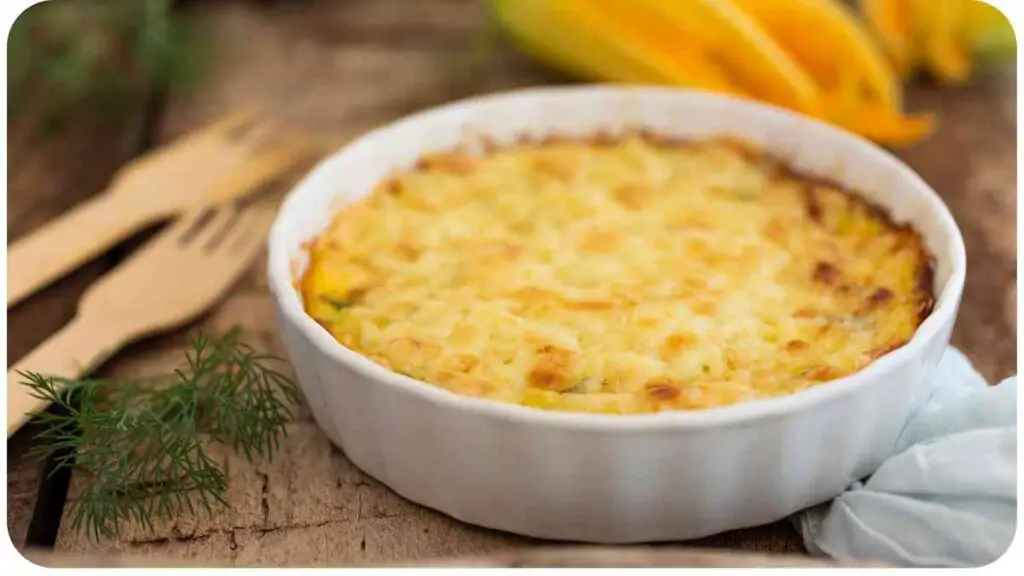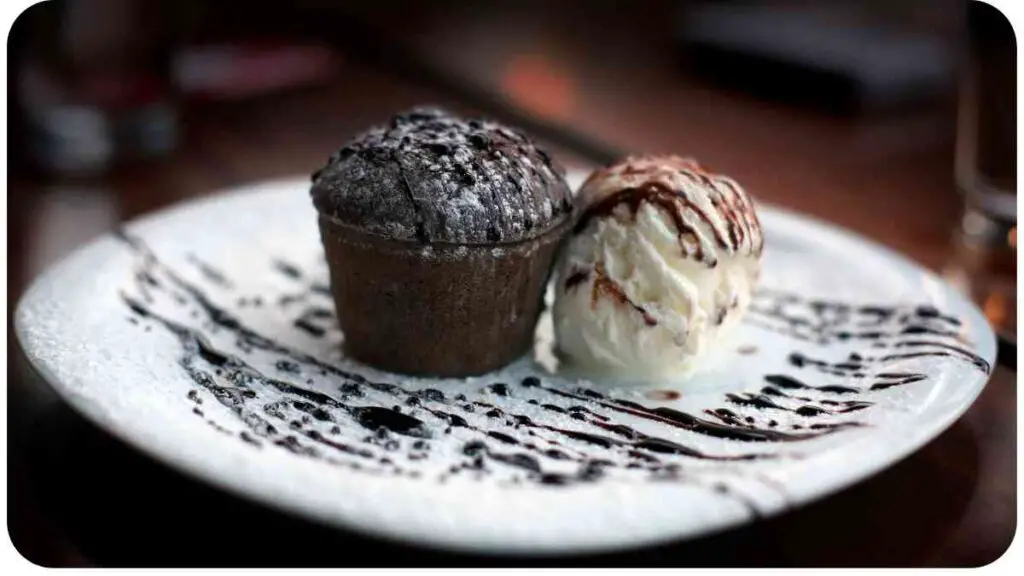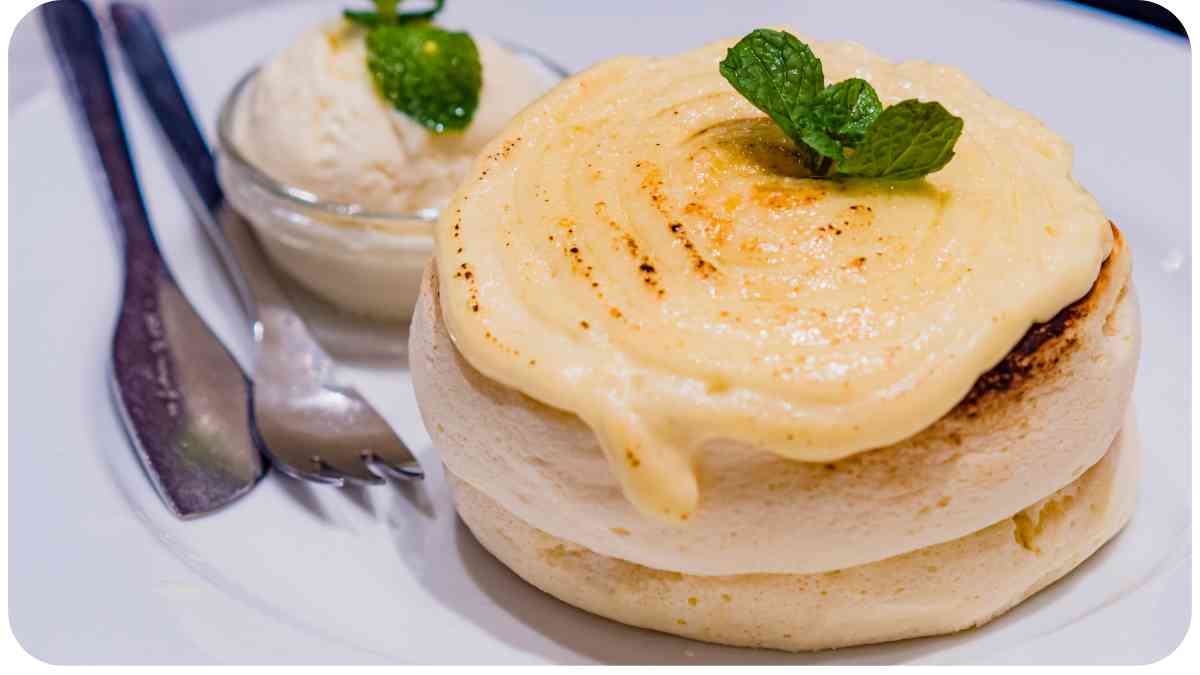Have you ever been frustrated when your soufflé didn’t rise as expected? Don’t worry; you’re not alone. Soufflés can be notoriously finicky, but with the right techniques and know-how, you can achieve a light, fluffy, and impressive dish that rises to perfection.
In this article, we’ll explore common pitfalls, provide tips for baking a perfect soufflé, troubleshoot potential issues, and even share some delicious variations.
| Takeaways |
| Master the Art of Making Soufflés |
| 1. Soufflés can be intimidating, but with practice and attention to key techniques, you can master them. |
| 2. Beating egg whites to stiff peaks is crucial for achieving a light and airy soufflé. |
| 3. Gently folding the egg whites into the base mixture helps preserve airiness and prevent deflation. |
| 4. Avoid opening the oven door while baking to maintain a consistent temperature. |
| 5. Pay attention to baking times and remove the soufflé when it’s lightly set but still slightly jiggly in the center. |
| 6. Experiment with different flavors and ingredients to create unique variations of soufflés. |
| 7. Soufflés are best served immediately after baking, as they tend to deflate quickly. |
| 8. Don’t be discouraged by failures; learn from them and keep trying. Soufflé mastery takes time and practice. |
2. Understanding the Common Pitfalls
Lack of a Sturdy Base
A soufflé needs a firm foundation to rise properly. Ensure your base ingredients, such as a roux or custard, are correctly prepared and adequately thickened. A runny base can result in a collapsed soufflé.
When it comes to baking, having the right tools is crucial for success. From the best mixers to essential pans, our kitchen gadgets for bakers guide will elevate your baking game.
Overmixing the Batter
While mixing the batter, avoid overmixing, as this can lead to a dense and flat soufflé. Gently fold in the beaten egg whites until just combined, preserving the air bubbles responsible for the rise.
Incorrect Folding Technique
Mastering the folding technique is crucial for achieving a light and airy soufflé. Use a gentle folding motion to incorporate the beaten egg whites into the base, maintaining as much volume as possible.
Inconsistent Oven Temperature
Inconsistent oven temperatures can wreak havoc on your soufflé. Invest in an oven thermometer to ensure accurate temperature readings. A fluctuating temperature can cause your soufflé to collapse or bake unevenly.
| Oven Temperature Recommendations |
| Preheat temperature: 375°F (190°C) |
| Baking temperature: 350°F (175°C) |
3. Tips for a Perfect Soufflé

Preparing the Base
To create a stable base, pay attention to the ratio of ingredients. Depending on the recipe, you may need to create a roux, whisk together a custard, or melt chocolate with other ingredients. Make sure to follow the instructions precisely and cook the base until it thickens and coats the back of a spoon.
Exploring a plant-based diet? Discover how to incorporate more vegetables into your meals for a healthier lifestyle. Learn the ins and outs of plant-based eating with our comprehensive guide.
Mastering the Folding Technique
When incorporating the beaten egg whites into the base, use a large spatula or a whisk with a gentle folding motion. This technique helps maintain the airiness of the egg whites, contributing to a light and fluffy texture.
Managing Oven Temperature
Ensure your oven is preheated correctly to the recommended temperature. Avoid opening the oven door during the initial baking stage, as drastic temperature fluctuations can cause the soufflé to collapse.
4. Troubleshooting Your Soufflé
Flat Soufflé
If your soufflé doesn’t rise much or ends up flat, the issue may lie in the egg whites. Ensure that they are whipped to stiff peaks before combining with the base mixture. The beaten egg whites should be glossy, with no liquid remaining. Additionally, confirm that your oven is at the correct temperature before baking.
Pizza perfection is an art, and these 10 secrets will turn you into a pizza-making pro. Find out how to make the perfect homemade pizza with our expert tips and tricks.
Sunken Soufflé
A soufflé can sink after being removed from the oven due to temperature changes or undercooking. To prevent this, bake the soufflé until it has beautifully risen and is lightly browned on top. Serve it immediately to enjoy its fully risen glory.
Dry or Gummy Texture
A dry or gummy texture suggests overbaking the soufflé. It’s crucial to monitor the baking time closely, as individual ovens may slightly vary. Aim for a lightly set center that still has a soft “jiggle” to maintain a moist and delicate interior.
Uneven Baking
If your soufflé bakes unevenly, consider rotating the dish halfway through the baking process. This ensures that the heat reaches all sides evenly, resulting in a consistent rise and golden crust.
Sharpen your culinary skills with essential knife techniques. Learn the importance of knife skills in the kitchen and how they can enhance your overall cooking experience.
5. Soufflé Variations and Tips
Classic Cheese Soufflé
The classic cheese soufflé never fails to impress. Incorporating flavorful grated cheese into the base mixture creates a delightful savory dish. Serve it as a main course or a show stopping appetizer. Here’s a simple table showing the ingredients for a classic cheese soufflé:
| Ingredients | Quantity |
| Butter | 2 tbsp |
| All-purpose flour | 2 tbsp |
| Whole milk | 1 cup |
| Grated cheese (Gruyère, Cheddar, or your choice) | 1 1/2 cups |
| Egg yolks | 4 |
| Salt | 1/2 tsp |
| Ground black pepper | 1/4 tsp |
| Egg whites | 4 |
To make the classic cheese soufflé, follow these steps:
- Preheat your oven to 375°F (190°C).
- Butter the inside of a soufflé dish and lightly coat it with grated cheese, tapping out any excess.
- In a saucepan, melt butter over medium heat, then whisk in the flour until smooth.
- Gradually add the milk, whisking constantly until the mixture thickens and comes to a boil.
- Remove from heat and stir in the grated cheese until melted and smooth.
- In a separate bowl, beat the egg yolks and season with salt and pepper.
- Slowly pour the cheese mixture into the beaten egg yolks, whisking continuously.
- In a clean bowl, beat the egg whites until stiff peaks form.
- Gently fold the beaten egg whites into the cheese mixture, being careful not to deflate the mixture.
- Pour the mixture into the prepared soufflé dish and smooth the top.
- Bake in the preheated oven for about 25-30 minutes, until the soufflé is puffed and golden.
- Serve immediately, as soufflés tend to deflate quickly.
Sweet Chocolate Soufflé

For those with a sweet tooth, a chocolate soufflé is an irresistible treat. Here’s a table showcasing the ingredients needed for a luscious chocolate soufflé:
We’ve all faced cooking mishaps. When your dish goes wrong, it’s time to turn it around. Explore easy recovery methods for burnt dishes, including fixing a burnt soup for a delicious outcome.
| Ingredients | Quantity |
| Unsalted butter | 2 tbsp |
| Granulated sugar | 2 tbsp |
| Bittersweet chocolate | 4 oz |
| Milk or heavy cream | 1/2 cup |
| Egg yolks | 4 |
| Egg whites | 6 |
| Salt | 1/4 tsp |
| Powdered sugar, for dusting | – |
To create a delectable chocolate soufflé, follow these steps:
- Preheat your oven to 375°F (190°C).
- Grease the inside of a soufflé dish with butter, then sprinkle granulated sugar, rotating the dish to coat evenly. Shake out any excess sugar.
- In a small saucepan, melt the bittersweet chocolate with milk or cream over low heat, stirring until smooth. Remove from heat and let it cool slightly.
- In a mixing bowl, whisk the egg yolks until creamy, then slowly pour in the melted chocolate mixture, stirring continuously.
- In a separate bowl, beat the egg whites and salt until soft peaks form.
- Gradually add powdered sugar to the egg whites and continue beating until stiff peaks form.
- Gently fold the beaten egg whites into the chocolate mixture, maintaining the airiness.
- Pour the mixture into the prepared soufflé dish, smoothing the top with a spatula.
- Bake in the preheated oven for about 15-18 minutes until the soufflé is well-risen and has a slight jiggle in the center.
- Sprinkle powdered sugar over the top and serve immediately, savoring the warm and decadent chocolate soufflé.
Savory Vegetable Soufflé
For a healthier option packed with flavor and nutrients, try a savory vegetable soufflé. Use seasonal vegetables of your choice to create a delightful twist on the classic dish. Here’s a table highlighting potential vegetables and other ingredients for a refreshing vegetable soufflé:
| Ingredients | Quantity |
| Assorted seasonal vegetables (e.g., zucchini, bell peppers, spinach, mushrooms) | 2 cups |
| Butter | 2 tbsp |
| All-purpose flour | 2 tbsp |
| Whole milk | 1 cup |
| Grated cheese (Parmesan, Gruyère, or your choice) | 1/2 cup |
| Egg yolks | 4 |
| Salt | 1/2 tsp |
| Ground black pepper | 1/4 tsp |
| Egg whites | 4 |
To prepare a savory vegetable soufflé, follow these steps:
- Preheat your oven to
375°F (190°C). 2. Prepare your assortment of vegetables by cleaning, chopping, and blanching them until tender. Drain well and set aside.
- In a saucepan, melt the butter over medium heat and whisk in the flour until smooth.
- Gradually add the milk to the saucepan, whisking continuously until the mixture thickens and comes to a boil.
- Remove from heat and stir in the grated cheese until melted and incorporated.
- In a separate bowl, beat the egg yolks and season with salt and pepper.
- Slowly pour the cheese mixture into the beaten egg yolks, whisking constantly.
- Add the cooked vegetables to the cheese and egg yolk mixture, stirring gently to combine.
- In a clean bowl, beat the egg whites until stiff peaks form.
- Carefully fold the beaten egg whites into the vegetable mixture, ensuring not to deflate the mixture.
- Pour the mixture into a greased soufflé dish and smooth the top.
- Bake in the preheated oven for about 25-30 minutes, until the soufflé is puffed and golden.
- Serve immediately, enjoying the delicious medley of vegetables and the lightness of the soufflé.
6. Conclusion
Making a soufflé may seem daunting at first, but with the right techniques and a bit of practice, you can become a soufflé master. Understanding the potential pitfalls and how to fix them, along with implementing tips for a perfect soufflé, will help you achieve impressive results every time.
Don’t be afraid to experiment with different flavors and ingredients, as the possibilities for soufflé variations are endless. So, put on your apron and dive into the world of soufflés to create culinary masterpieces that rise to perfection and delight your taste buds. Bon appétit!
Further Reading
What is a Soufflé? 8 Tips for Cooking the Perfect Soufflé and 2 Easy Soufflé Methods
This MasterClass article provides an overview of soufflés, including what they are and tips for cooking the perfect soufflé. It also includes two easy soufflé methods, making it a great resource for beginners and experienced cooks alike.
Fear of Falling: Why Bad Soufflés Happen to Good Cooks
This article from The Washington Post explores the common fears and challenges associated with making soufflés. It discusses the reasons behind failed soufflés and offers helpful insights and tips for overcoming them, providing valuable advice for home cooks striving for success.
Tips & Tricks for Conquering Homemade Soufflés
From the Food Hacks section of WonderHowTo, this article offers practical tips and tricks for mastering homemade soufflés. It covers various aspects of soufflé preparation, from ingredients and techniques to troubleshooting common issues, providing useful guidance for improving your soufflé-making skills.
FAQs
How do I prevent my soufflé from collapsing?
To prevent your soufflé from collapsing, make sure to beat the egg whites to stiff peaks before incorporating them into the base mixture. Also, ensure that your oven is at the correct temperature and avoid opening the oven door during baking to maintain a consistent temperature.
Why is my soufflé flat?
If your soufflé does not rise much or ends up flat, it may be due to improperly beaten egg whites. Make sure to beat the egg whites until they are stiff and glossy, with no liquid remaining. Additionally, confirm that your oven is at the correct temperature for baking.
What can I do if my soufflé turns out dry or gummy?
If your soufflé has a dry or gummy texture, it may have been overbaked. Pay close attention to the baking time and remove the soufflé from the oven when it is lightly set but still slightly jiggly in the center. This will help maintain a moist and delicate texture.
How can I achieve a light and fluffy soufflé?
To achieve a light and fluffy soufflé, it is important to master the folding technique. Gently fold the beaten egg whites into the base mixture using a large spatula or whisk, being careful not to deflate the mixture. This will help preserve the air bubbles and contribute to the desired texture.
Can I make a soufflé in advance?
Soufflés are best served immediately after baking because they tend to deflate quickly. While it is not recommended to make them in advance, you can prepare the base mixture and whip the egg whites ahead of time. Just fold in the egg whites right before baking to ensure the best rise and texture.
Further Reading
What is a Soufflé? 8 Tips for Cooking the Perfect Soufflé and 2 Easy Soufflé Methods
This MasterClass article provides an overview of soufflés and offers eight tips for cooking the perfect soufflé. It also includes two easy soufflé methods, making it a helpful resource for both beginners and experienced cooks.
Fear of Falling: Why Bad Soufflés Happen to Good Cooks
In this Washington Post article, you’ll learn about the common fears and challenges associated with making soufflés. It discusses the reasons behind failed soufflés and provides valuable insights and tips for overcoming them, offering helpful advice for home cooks.
Tips & Tricks for Conquering Homemade Soufflés
This article from the Food Hacks section of WonderHowTo offers practical tips and tricks for mastering homemade soufflés. It covers various aspects of soufflé preparation, including ingredients, techniques, and troubleshooting common issues, providing useful guidance for improving your soufflé-making skills.
FAQs
How do I prevent my soufflé from collapsing?
To prevent your soufflé from collapsing, it’s crucial to beat the egg whites to stiff peaks before gently folding them into the base mixture. Additionally, avoid opening the oven door while baking and ensure your oven is at the correct temperature for the recipe.
Why is my soufflé flat?
A flat soufflé could be the result of underbeaten egg whites or overmixing the batter. Be sure to beat the egg whites until stiff peaks form and fold them into the base mixture just until combined. It’s also essential to avoid overbaking, as this can cause the soufflé to shrink and flatten.
What can I do if my soufflé turns out dry or gummy?
If your soufflé has a dry or gummy texture, it may be the result of overbaking. Remember to follow the recommended baking time and remove the soufflé from the oven when it is set on the outside but still slightly jiggly in the center for a moist and airy result.
How can I achieve a light and fluffy soufflé?
To achieve a light and fluffy soufflé, make sure to incorporate the beaten egg whites gently. Use a folding technique to combine the egg whites with the base mixture to preserve the airiness. Avoid overmixing, which can cause the soufflé to lose its light texture.
Can I make a soufflé in advance?
Soufflés are best served immediately after baking, as they tend to deflate quickly. While it’s not recommended to make them in advance, you can prepare the base mixture and whip the egg whites ahead of time. When you’re ready to bake, fold the egg whites into the base and proceed with baking for the best results.

Hi, I’m Hellen James! I’m a professional chef who has been cooking for over 12 years. In my career, I’ve worked at some of the world’s most prestigious hotels and restaurants. My expertise lies in creating recipes that are simple but delicious, and I love to experiment with new ingredients and techniques. I started this blog because I want to share my passion for cooking with everyone who loves food as much as I do.


